Xingqi Zhang
Electromagnetic Degrees of Freedom for Continuous-Aperture Array (CAPA) Systems
Feb 20, 2025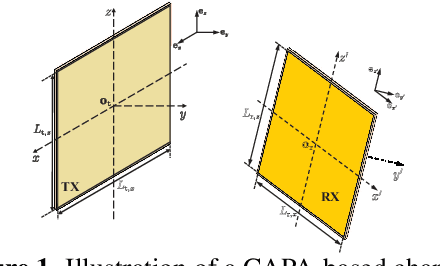
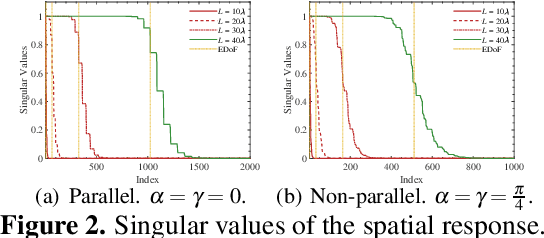
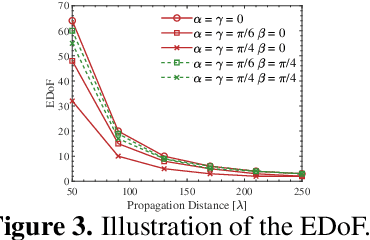
Abstract:The spatial degrees of freedom (DoFs) of a continuous-aperture array (CAPA)-based continuous electromagnetic (EM) channel are analyzed. To this end, a simplified spatial model is derived using the Fresnel approximation. Leveraging this model and Landau's theorem, a closed-form expression for the spatial DoFs is derived. It is demonstrated that the number of DoFs is proportional to the transmit and receive aperture sizes while being inversely proportional to the propagation distance. Numerical results are provided to validate the accuracy of the derived expressions.
Electromagnetic Channel Statistics for Continuous-Aperture Array (CAPA) Systems
Feb 10, 2025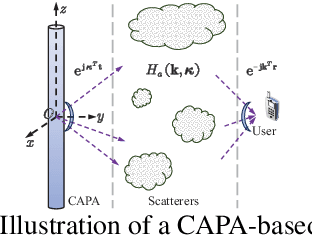
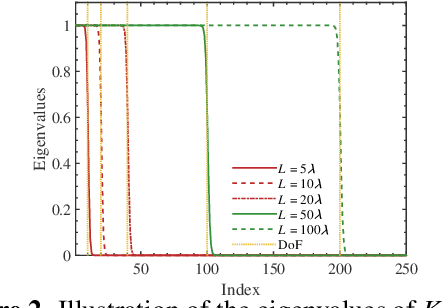
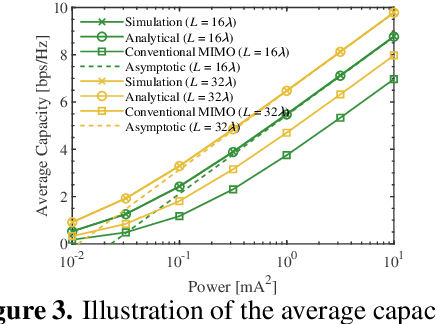
Abstract:The channel statistics of a continuous-aperture array (CAPA)-based channel are analyzed using its continuous electromagnetic (EM) properties. The received signal-to-noise ratio (SNR) is discussed under isotropic scattering conditions. Using Landau's theorem, the eigenvalues of the autocorrelation of the EM fading channel are shown to exhibit a step-like behavior. Building on this, closed-form expressions for the probability distribution of the SNR and the average channel capacity are derived. Numerical results are provided to validate the accuracy of the derivations.
Downlink and Uplink ISAC in Continuous-Aperture Array (CAPA) Systems
Feb 10, 2025



Abstract:A continuous-aperture array (CAPA)-based integrated sensing and communications (ISAC) framework is proposed for both downlink and uplink scenarios. Within this framework, continuous operator-based signal models are employed to describe the sensing and communication processes. The performance of communication and sensing is analyzed using two information-theoretic metrics: the communication rate (CR) and the sensing rate (SR). 1) For downlink ISAC, three continuous beamforming designs are proposed: i) the communications-centric (C-C) design that maximizes the CR, ii) the sensing-centric (S-C) design that maximizes the SR, and iii) the Pareto-optimal design that characterizes the Pareto boundary of the CR-SR region. A signal subspace-based approach is proposed to derive the closed-form optimal beamformers for the considered designs. On this basis, closed-form expressions are derived for the achievable CRs and SRs, and the downlink rate region achieved by CAPAs is characterized. 2) For uplink ISAC, the C-C and S-C successive interference cancellation (SIC)-based methods are proposed to manage inter-functionality interference. Using the subspace approach along with the time-sharing technique, closed-form expressions for the optimal beamformers are derived, and the achievable CRs, SRs, and rate region are analyzed. Numerical results demonstrate that, for both downlink and uplink, CAPA-based ISAC achieves higher CRs and SRs as well as larger CR-SR regions compared to conventional spatially discrete array (SPDA)-based ISAC.
Secure Wireless Communications via Frequency Diverse Arrays
Dec 29, 2024


Abstract:A novel frequency diverse array (FDA)-assisted secure transmission framework is proposed, which leverages additional frequency offsets to enhance physical layer security. Specifically, an FDA-assisted wiretap channel is considered, where the transmit beamforming and frequency offsets at each antenna are jointly optimized. A novel alternating optimization-based method is introduced to address the non-convex problem of secure transmission, focusing on minimizing transmit power and maximizing the secrecy rate. Numerical results are provided to demonstrate the superiority of the FDA-based framework compared to systems employing traditional phased array antennas in secure transmission.
Movable Antenna Aided Physical Layer Security with No Eavesdropper CSI
Dec 27, 2024



Abstract:A novel movable antenna (MA)-aided secure transmission framework is proposed to enhance the secrecy transmission rate without relying on the eavesdropper's channel state information. Within this framework, a joint beamforming and jamming scheme is proposed, where the power of the confidential signal is minimized by optimizing the positions of the MAs, and the residual power is used to jam the eavesdropper. An efficient gradient-based method is employed to solve this non-convex problem. Numerical results are provided to demonstrate the superiority of the MA-based framework over systems using traditional fixed-position antennas in secure transmission.
Physical Layer Security for Continuous-Aperture Array (CAPA) Systems
Dec 18, 2024Abstract:A continuous-aperture array (CAPA)-based secure transmission framework is proposed to enhance physical layer security. Continuous current distributions, or beamformers, are designed to maximize the secrecy transmission rate under a power constraint and to minimize the required transmission power for achieving a specific target secrecy rate. On this basis, the fundamental secrecy performance limits achieved by CAPAs are analyzed by deriving closed-form expressions for the maximum secrecy rate (MSR) and minimum required power (MRP), along with the corresponding optimal current distributions. To provide further insights, asymptotic analyses are performed for the MSR and MRP, which reveals that i) for the MSR, the optimal current distribution simplifies to maximal ratio transmission (MRT) beamforming in the low-SNR regime and to zero-forcing (ZF) beamforming in the high-SNR regime; i) for the MRP, the optimal current distribution simplifies to ZF beamforming in the high-SNR regime. The derived results are specialized to the typical array structures, e.g., planar CAPAs and planar spatially discrete arrays (SPDAs). The rate and power scaling laws are further analyzed by assuming an infinitely large CAPA. Numerical results demonstrate that: i) the proposed secure continuous beamforming design outperforms MRT and ZF beamforming in terms of both achievable secrecy rate and power efficiency; ii) CAPAs achieve superior secrecy performance compared to conventional SPDAs.
Performance of Linear Receive Beamforming for Continuous Aperture Arrays (CAPAs)
Nov 14, 2024Abstract:The performance of linear receive beamforming in continuous aperture array (CAPA)-based uplink communications is analyzed. Continuous linear beamforming techniques are proposed for CAPA receivers under the criteria of maximum-ratio combining (MRC), zero-forcing (ZF), and minimum mean-square error (MMSE). i) For MRC beamforming, a closed-form expression for the beamformer is derived to maximize per-user signal power, and the achieved uplink rate and mean-square error (MSE) in detecting received data symbols are analyzed. ii) For ZF beamforming, a closed-form beamformer is derived using channel correlation to eliminate interference, with a function space interpretation demonstrating its optimality in maximizing signal power while ensuring zero inter-user interference. iii) For MMSE beamforming, it is proven to be the optimal linear receive approach for CAPAs in terms of maximizing per-user rate and minimizing MSE. A closed-form expression for the MMSE beamformer is then derived, along with the achievable sum-rate and sum-MSE. The proposed linear beamforming techniques are then compared with those for conventional spatially discrete arrays (SPDAs). Analytical and numerical results indicate that: i) for both CAPAs and SPDAs, the considered linear beamformers can be represented as weighted sums of each user's spatial response, with weights determined by channel correlation; ii) CAPAs achieve higher sum-rates and lower sum-MSEs than SPDAs under ZF and MMSE beamforming; and iii) SPDAs may outperform CAPAs with MRC beamforming in interference-dominated scenarios.
Diversity and Multiplexing for Continuous Aperture Array (CAPA)-Based Communications
Aug 25, 2024Abstract:The performance of multiplexing and diversity achieved by continuous aperture arrays (CAPAs) over fading channels is analyzed. Angular-domain fading models are derived for CAPA-based multiple-input single-output (MISO), single-input multiple-output (SIMO), and multiple-input multiple-output (MIMO) channels using the Fourier relationship between the spatial response and its angular-domain counterpart. Building on these models, angular-domain transmission frameworks are proposed to facilitate CAPA-based communications, under which the performance of multiplexing and diversity is analyzed. 1) For SIMO and MISO channels, closed-form expressions are derived for the average data rate (ADR) and outage probability (OP). Additionally, asymptotic analyses are performed in the high signal-to-noise ratio (SNR) regime to unveil the maximal multiplexing gain and maximal diversity gain. The diversity-multiplexing trade-off (DMT) is also characterized, along with the array gain within the DMT framework. 2) For MIMO channels, high-SNR approximations are derived for the ADR and OP, based on which the DMT and associated array gain are revealed. The performance of CAPAs is further compared with that of conventional spatially discrete arrays (SPDAs) to highlight the superiority of CAPAs. The analytical and numerical results demonstrate that: i) compared to SPDAs, CAPAs achieve a lower OP and higher ADR, resulting in better spectral efficiency; ii) CAPAs achieve the same DMT as SPDAs with half-wavelength antenna spacing while attaining a larger array gain; and iii) CAPAs achieve a better DMT than SPDAs with antenna spacing greater than half a wavelength.
Performance Analysis of Physical Layer Security: From Far-Field to Near-Field
Aug 20, 2024
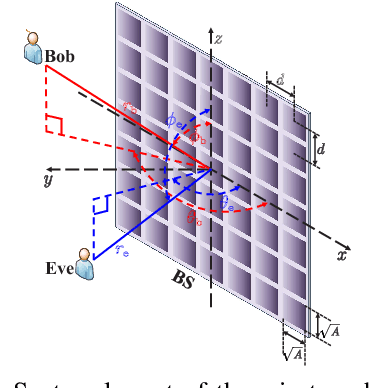
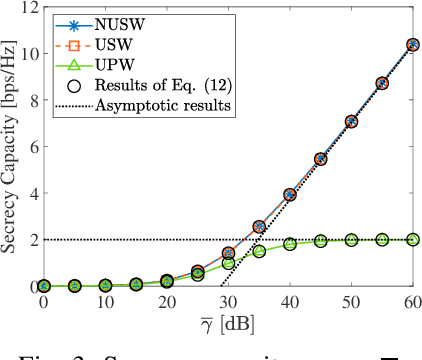
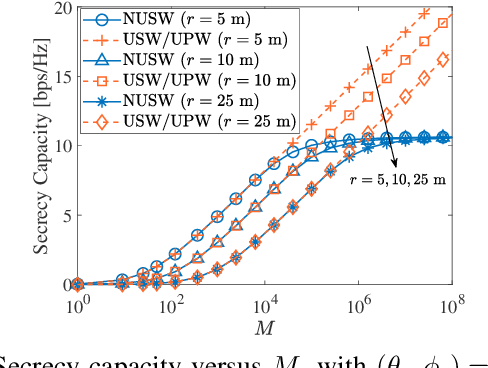
Abstract:The secrecy performance in both near-field and far-field communications is analyzed using two fundamental metrics: the secrecy capacity under a power constraint and the minimum power requirement to achieve a specified secrecy rate target. 1) For the secrecy capacity, a closed-form expression is derived under a discrete-time memoryless setup. This expression is further analyzed under several far-field and near-field channel models, and the capacity scaling law is revealed by assuming an infinitely large transmit array and an infinitely high power. A novel concept of "depth of insecurity" is proposed to evaluate the secrecy performance achieved by near-field beamfocusing. It is demonstrated that increasing the number of transmit antennas reduces this depth and thus improves the secrecy performance. 2) Regarding the minimum required power, a closed-form expression is derived and analyzed within far-field and near-field scenarios. Asymptotic analyses are performed by setting the number of transmit antennas to infinity to unveil the power scaling law. Numerical results are provided to demonstrate that: i) compared to far-field communications, near-field communications expand the areas where secure transmission is feasible, specifically when the eavesdropper is located in the same direction as the intended receiver; ii) as the number of transmit antennas increases, neither the secrecy capacity nor the minimum required power scales or vanishes unboundedly, adhering to the principle of energy conservation.
Continuous Aperture Array (CAPA)-Based Wireless Communications: Capacity Characterization
Jun 21, 2024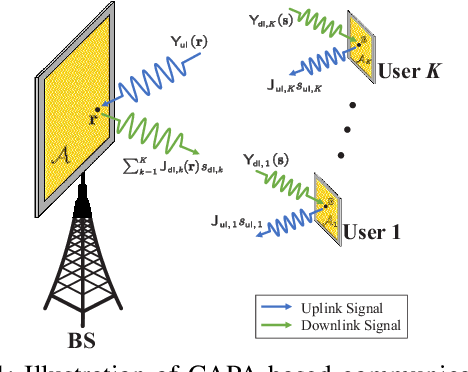
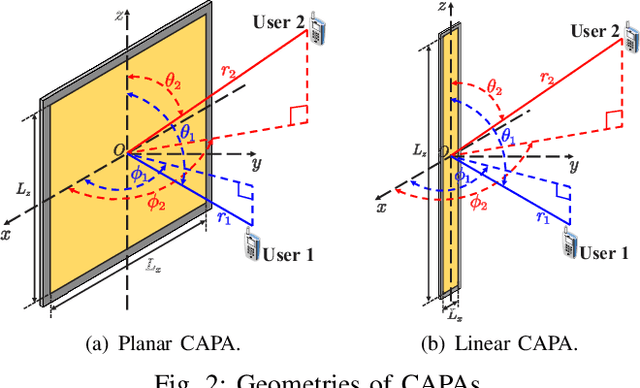
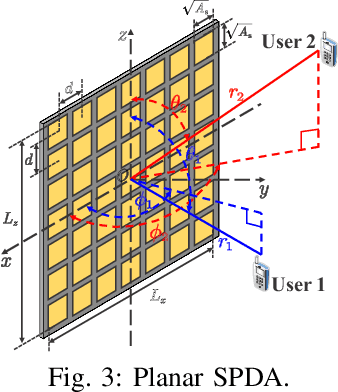
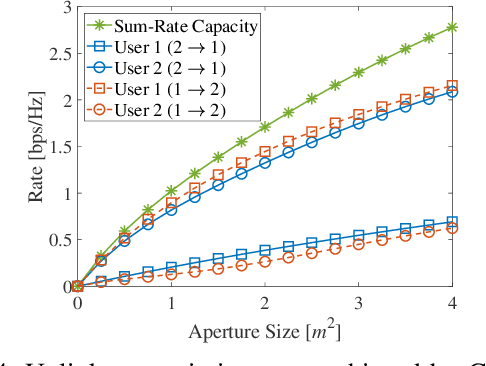
Abstract:The capacity limits of continuous-aperture array (CAPA)-based wireless communications are characterized. To this end, an analytically tractable transmission framework is established for both uplink and downlink CAPA systems. Based on this framework, closed-form expressions for the single-user channel capacity are derived. The results are further extended to a multiuser case by characterizing the capacity limits of a two-user channel and proposing the associated capacity-achieving decoding and encoding schemes. 1) For the uplink case, the sum-rate capacity and capacity region, as well as the capacity-achieving detectors, are derived. 2) For the downlink case, the uplink-downlink duality is established by deriving the uplink-to-downlink and downlink-to-uplink transformations under the same power constraint, based on which the optimal power allocation policy and the achieved sum-rate capacity and capacity region are characterized. To gain further insights, several case studies are presented by specializing the derived results into various array structures, including the planar CAPA, linear CAPA, and planar spatially discrete array (SPDA). Numerical results are provided to reveal that: i) the channel capacity achieved by CAPAs converges towards a finite upper bound as the aperture size increases; and ii) CAPAs offer significant capacity gains over the conventional SPDAs.
 Add to Chrome
Add to Chrome Add to Firefox
Add to Firefox Add to Edge
Add to Edge